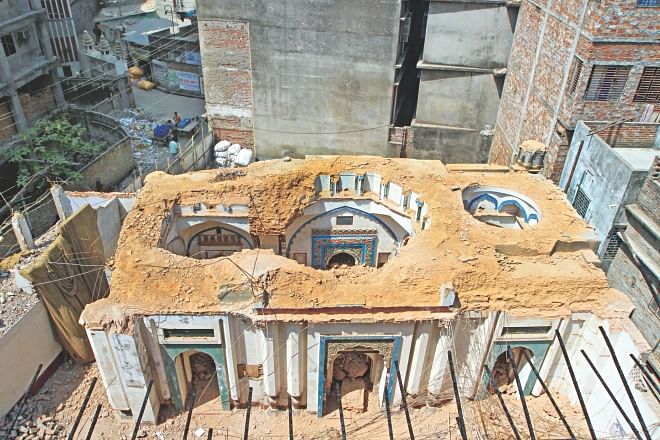Historical buildings plundered

At least 33 Mughal and British era structures in Old Dhaka have been demolished in the last four months, as none of the authorities concerned took the responsibility to preserve them.
Five more buildings, four in Hrishikesh Das Lane and one in Shakhari Bazar are going to go flat, if not prevented, having secured Rajuk permission for demolition.
The Urban Development Committee was entrusted with the task of maintaining and preserving the sites older than a century with heritage value or antiquities as defined in the Antiquity Act.
However, the committee claims the responsibility has been transferred to the Ministry of Cultural Affairs and the Department of Archaeology.
Formed in 2004, the Urban Development Committee has neglected its duty although the High Court in 2012 directed the authorities concerned to assess the heritage value of these buildings for preservation.
The HC instructed the cultural affairs ministry, Rajdhani Unnayan Kartripakkha (Rajuk) and the public works secretary to update a list within three months and publish a gazette to that end a week later.
The list has not been updated till date, nor has the gazette been published.
The committee has even failed to attach "protected" status on the demolished sites like it had done to 94 sites in 2009.Contacted, Rajuk Chairman Nurul Huda told The Daily Star that the responsibility had been shifted from them to the Department of Archaeology late last year.
Ataur Rahman, director of the Department of Archaeology, Dhaka region, admitted the fact. He said, "We have decided to survey the sites to see whether they can be considered for protection."
As the authorities had been trying to figure out who was responsible for saving the buildings, demolition of the antiquities continued, wiping off the architectural history of the ancient part of the capital.
The most recent demolition took place in Hatkhola, Aga Masih Lane, Nazira Bazar, Lakshmibazar, Armani Tola and Kotwali areas.
"Ward-67 and 68 of Dhaka are losing their antiquity fast," said Taimur Islam, chief executive officer of Urban Study Group.
At least 19 buildings have been demolished in Kotwali alone, according to a survey by the study group.
There are no historic buildings left on Kazi Alauddin Road at Nazira Bazar after the last six had been taken down in the latest demolition spree.
The five buildings demolished in Lakshmibazar were particularly valuable for their beautiful architecture, said Taimur.
"The walls were intricately decorated. They had magnificently crafted cornices, balconies with embellished columns and railings of carved wood or wrought iron," he added.
One of the most prominent among the recently razed buildings was the 324-year-old Hingi Bibi Jam-e Mosque on KP Ghosh Lane at Armanitola.
Fabled to have been constructed in 1119 Hijri, according to Imam Maulana Rahmatullah, chief khatib of the mosque for 40 years, the structure had endured the ravages of time only to crumble under human will. The mosque committee began demolishing the structure about a month ago.
Although the demolition was stopped before the mosque was totally levelled, very little is left of the three-domed structure ornately decorated with hand-painted mosaic.
All three of its domes have been demolished.
"The mosque was not listed as a heritage site, so it was not our responsibility," claimed Rajuk's authorised officer for the area AZM Shafiur Hannan.
Since the damage has already been done, Regional Director of the Department of Archaeology Ataur Rahman was asked if any steps would be taken to restore it.
"Well, not definitely in this fiscal year. Maybe we can think about it in the next fiscal year," he said.
Mosque committee chairperson Saber Ahmed claimed that the demolition was "necessary" to save the devotees from any disaster.
However, the structure's durability was not in question, said Taimur. "It was built using lime-masonry instead of concrete, which made it more resistant to earthquakes," he said.
Taimur told The Daily Star only around 34 archetypal Mughal structures were left in the city with others being razed over the centuries.
"In addition, there are about 60 Mughal buildings in Shakhari Bazar, almost all of which have been through extensive modification during the British rule," he added.

 For all latest news, follow The Daily Star's Google News channel.
For all latest news, follow The Daily Star's Google News channel. 



Comments